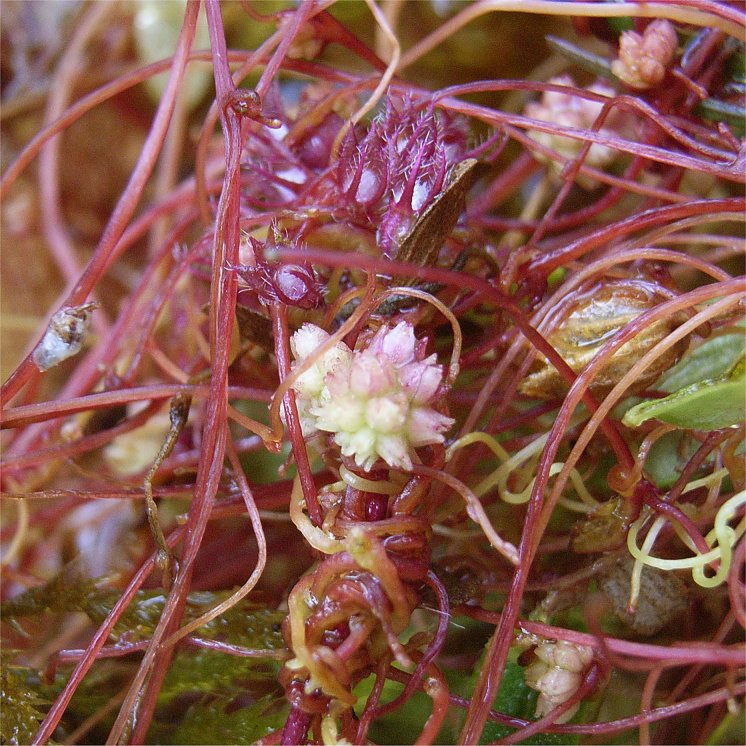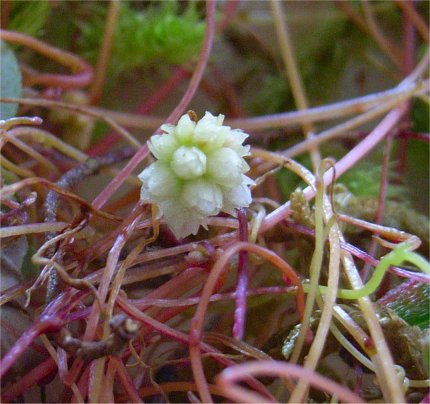Back to the Annual Report Contents and Home page
Botany Report for 2007
by Gill Smith
2007 was another strange year for weather, effectively a year without either a winter or a summer – and heavy rain in June that caused serious floods around Hull and Doncaster in Yorkshire, and the Severn valley further afield. I found red campion and ragwort still in flower in early January. By mid-month new shoots of bluebells, garlic, cuckoo pint, dog’s mercury, primroses and golden saxifrage were all showing. I even found a primrose in flower on 28th – the first I’ve seen in January in Ryedale. Tom reported the first at Rudland on 4th March. Another early flowerer was climbing corydalis on March 12th at Bulmer Hagg just outside our area. It was a particularly good year for sweet violets, especially the white variety.
Easter weekend (8th April) saw the daffodils at Lowna putting on a good show, but there was no sign of green on the trees, which was unusual. In fact the second half of April was quite cold and dry, so the countryside didn’t turn green till about 28th, and the ashes were later still, not coming into leaf till June. There never seemed to be any real summer weather with hot sunny days, but most of the plants seemed to flower quite well anyway. After the wet early summer autumn was mostly dry, and the holly had an incredible number of berries – also plenty of sloes, crab apples, black bryony berries and haws (and pears, plums and apples in the garden). The autumn colours were good but late, at their best in the first week of November. The first real frost was overnight 16-17th November, very late.

 The undoubted highlight was the discovery of dodder in Gundale by Nan with Margaret Atherden (photo above and detail right, both © Nan Sykes). Although we are north of its normal range there are old records of it from on or near this site. It is a strange, parasitic plant with no green leaves of its own.
For some reason it was a dreadful year for orchids, with very few flowering at Yatts Farm, no small white orchid spikes seen at all at Biller Howe, and only 4 butterfly orchids and 1 fragrant recorded from Rudland. It also seemed to be a poor year for baneberry both at Gilling and Ashberry: one wonders if this is a reflection of global warming, as this is a plant that seems to have a restricted range latitudinally (and as it requires limestone moving north from the Corallian escarpment will be impossible). The New Zealand Cotula mentioned in last year’s report continues to thrive at its site on Rudland Rigg.
The undoubted highlight was the discovery of dodder in Gundale by Nan with Margaret Atherden (photo above and detail right, both © Nan Sykes). Although we are north of its normal range there are old records of it from on or near this site. It is a strange, parasitic plant with no green leaves of its own.
For some reason it was a dreadful year for orchids, with very few flowering at Yatts Farm, no small white orchid spikes seen at all at Biller Howe, and only 4 butterfly orchids and 1 fragrant recorded from Rudland. It also seemed to be a poor year for baneberry both at Gilling and Ashberry: one wonders if this is a reflection of global warming, as this is a plant that seems to have a restricted range latitudinally (and as it requires limestone moving north from the Corallian escarpment will be impossible). The New Zealand Cotula mentioned in last year’s report continues to thrive at its site on Rudland Rigg.
In terms of personal highlights I was delighted to see a large patch of goldilocks buttercups in Helmsley churchyard, and cream tuberous comfrey in Yearsley woods in early May. I found wood stitchwort flowering on the riverbank just upstream of Kirkdale Minster, and meadow saxifrage at Ashberry. Of course the tufted loosestrife at Gormire was a particular thrill, especially seeing it in flower (several of the books claim it does not flower this far north!). Other new plants for me were ploughman’s spikenard, a hybrid woundwort (hedge×marsh) and the tiny knotted hedge parsley, all growing on Hutton Common – with tall woolly thistles close by; oxtongue hawkweed near Gillamoor, and rough hawksbeard at Slingsby crossroads. I also found night-flowering catchfly at Whitwell just outside our area; Bill Thompson found it within the area at Slingsby and Stonegrave.
Bill sent me many other records, including those for two “hotspot” sites at Hutton Common (with deadly nightshade, houndstongue, ploughman’s spikenard, woolly thistle amongst others) and the area around Slingsby including Bank Lane where he found field garlic, and a nearby quarry with bur chervil. I also received records from Nan Sykes, Rhona Sutherland and Tom & Janet Denney, and a report of an escaped milk thistle near Hamley Hagg. These are very welcome, and will help to build up a valuable database of Ryedale plants and where they grow. As more of our farmland and roadside verges seem to be losing their variety it is important that we know where the remaining good areas remain, and try to conserve them. I get the impression that “unimproved” grassland is the most endangered habitat, because it is so easy to destroy: one application of fertiliser or herbicide, or the modern fad for trimming verges to resemble lawns, is all it takes.
Back to the Annual Report Contents and Home page
 The undoubted highlight was the discovery of dodder in Gundale by Nan with Margaret Atherden (photo above and detail right, both © Nan Sykes). Although we are north of its normal range there are old records of it from on or near this site. It is a strange, parasitic plant with no green leaves of its own.
For some reason it was a dreadful year for orchids, with very few flowering at Yatts Farm, no small white orchid spikes seen at all at Biller Howe, and only 4 butterfly orchids and 1 fragrant recorded from Rudland. It also seemed to be a poor year for baneberry both at Gilling and Ashberry: one wonders if this is a reflection of global warming, as this is a plant that seems to have a restricted range latitudinally (and as it requires limestone moving north from the Corallian escarpment will be impossible). The New Zealand Cotula mentioned in last year’s report continues to thrive at its site on Rudland Rigg.
The undoubted highlight was the discovery of dodder in Gundale by Nan with Margaret Atherden (photo above and detail right, both © Nan Sykes). Although we are north of its normal range there are old records of it from on or near this site. It is a strange, parasitic plant with no green leaves of its own.
For some reason it was a dreadful year for orchids, with very few flowering at Yatts Farm, no small white orchid spikes seen at all at Biller Howe, and only 4 butterfly orchids and 1 fragrant recorded from Rudland. It also seemed to be a poor year for baneberry both at Gilling and Ashberry: one wonders if this is a reflection of global warming, as this is a plant that seems to have a restricted range latitudinally (and as it requires limestone moving north from the Corallian escarpment will be impossible). The New Zealand Cotula mentioned in last year’s report continues to thrive at its site on Rudland Rigg.
